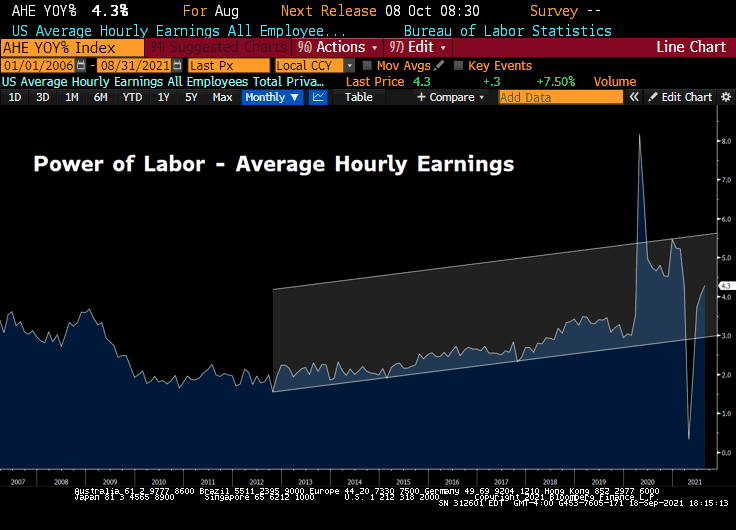Don’t miss our next trade idea. Get on the Bear Traps Report Today, click here
The winds of secular change are howling, but is anyone listening? We see a colossal impact on asset prices in the months ahead. The clues do litter the field with one of the most telling coming from our planet´s largest online retailer. Case in point – Amazon’s productivity continues to improve across its roughly 1.4 million employees. As a result, the company can pay them more and still gush cash. Looking at real impact – for its next 125,000 workers, minimum pay has been set at $18 an hour. This means that any business competing with Amazon for workers will have to pay up. We call this wage inflation. So while productivity enhancements by Amazon are disinflationary considered in and of themselves, they are inflationary in their knock-on effects on wage-price pressures on other businesses. And there is an even broader psychological impact. When workers see a minimum pay at $18 away, they will be more vocal about wanting a higher wage for the job they already have. This is how labor strikes get lit. The power of labor is getting a big boost from Amazon. Strikes by Amazon workers in Italy, Germany, and India are bubbling into an international struggle against the world’s fourth-most valuable company – now they are paying attention. International efforts against Amazon have been building for some time. The UNI Global Union helped mobilize thousands of Amazon workers in four European countries to strike in recent years. Momentum is on the rise.
Average hourly earnings climbed by 0.6% from July to August, more than the 0.3% that economists in a Bloomberg survey had forecast. Over the past year, they were up 4.3%, exceeding the expected 3.9%. Pay has been climbing strongly in recent months as job openings have exceeded the number of people actively looking for work. Why is this important? We count $100T of global wealth shoe-horned into deflation assets (growth stocks, negative-yielding bonds, bonds below 2% in yield). This is a COLOSSAL bet on transitory inflation.
Hot AHE – Secular Change in the Power of Labor
 For decades, the foundation of “transitory inflation” has been found in the power of labor. The less powerful the labor force the more transitory inflation has become. Since the 1980s, the power of labor has been in secular decline. The kick-off came when the Reagan administration fired the 11,345 striking air traffic controllers, and banned them from federal service for life. In recent years, these tables have turned powered by the Covid-pandemic and a back-to-back fire hose of $3T deficits coming out of Washington (2020 and 2021, $6T deficit spending in total). In recent years, Amazon was criticized for paying workers $12-$14 an hour, now they are up at $18-$19. Everyone knows there are 5.5 million fewer workers in the U.S. labor force (per BLS data) today vs. 2019. At the same time – U.S. JOLTS data, jobs openings are 50% greater than 2019 levels. That is at least two standard deviations above the ten-year mean number of available jobs. So, next time someone tries to sell you on “transitory inflation” – look at the data, labor has more power today in terms of influence on wages than they have had in 20 years.
For decades, the foundation of “transitory inflation” has been found in the power of labor. The less powerful the labor force the more transitory inflation has become. Since the 1980s, the power of labor has been in secular decline. The kick-off came when the Reagan administration fired the 11,345 striking air traffic controllers, and banned them from federal service for life. In recent years, these tables have turned powered by the Covid-pandemic and a back-to-back fire hose of $3T deficits coming out of Washington (2020 and 2021, $6T deficit spending in total). In recent years, Amazon was criticized for paying workers $12-$14 an hour, now they are up at $18-$19. Everyone knows there are 5.5 million fewer workers in the U.S. labor force (per BLS data) today vs. 2019. At the same time – U.S. JOLTS data, jobs openings are 50% greater than 2019 levels. That is at least two standard deviations above the ten-year mean number of available jobs. So, next time someone tries to sell you on “transitory inflation” – look at the data, labor has more power today in terms of influence on wages than they have had in 20 years.


